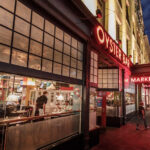King Street Station stands as a testament to Seattle’s rich history and its vital role as a major transportation hub in the Pacific Northwest. For over a century, this iconic station has served as a welcoming gateway for millions of travelers, fostering economic growth and solidifying Seattle’s position as a leading metropolitan city. Today, King Street Station continues to thrive, serving over 2.7 million passengers annually who utilize Amtrak, Sounder commuter trains, and Amtrak Thruway bus services. Its strategic location also provides seamless connections to various transportation options, including Sound Transit commuter rail, local and regional buses, Sound Transit Link light rail, and the First Hill Seattle Streetcar, making it a truly integrated transportation center.
Originally opened in May 1906, King Street Station is a masterpiece designed by the renowned architectural firm of Reed and Stem, the same minds behind New York City’s iconic Grand Central Terminal. The station’s design draws inspiration from the San Marco bell tower in Venice, Italy, most notably reflected in its distinctive clock tower, a beloved feature of the Seattle skyline. Recognized for its historical and architectural significance, King Street Station was rightfully placed on the National Register of Historic Places in 1973, ensuring its preservation for future generations.
Located on Jackson Street, nestled between 3rd and 4th Avenue South, King Street Station is an impressive three-story structure constructed from brick and granite, further distinguished by its twelve-story clock tower. The ground floor, accessible from King Street, is clad in robust granite, while the upper levels and clock tower showcase pressed brick adorned with decorative terra cotta elements, including cornices and window lintels. These architectural details speak to the grandeur and craftsmanship of the early 20th century.
Stepping inside King Street Station reveals a grand waiting room, a space designed to impress and welcome travelers. Ornamental plaster ceilings and stately fluted Corinthian columns define the interior, while bronze chandeliers and wall sconces cast a warm, inviting light. The terrazzo floor is intricately designed with inlaid square mosaic tiles, creating a compass pattern at the main entrance and rectangular patterns throughout the station, adding to the aesthetic richness of the space.
While King Street Station’s exterior has largely retained its original 1906 character, the interior underwent significant alterations during renovations in the 1940s, 50s, and 60s, and also suffered from periods of neglect. Recognizing the station’s importance and diminishing grandeur, the City of Seattle took a significant step in February 2008, purchasing the landmark building for a symbolic $10 from Burlington Northern Santa Fe Railway Company. This acquisition marked the beginning of a dedicated effort to restore King Street Station to its former glory, reminiscent of America’s Gilded Age. The comprehensive restoration project was undertaken to ensure that King Street Station would not only remain a vital transportation hub but also continue to serve as a magnificent gateway to Seattle for another century.
Beyond its transportation function, Seattle is now fostering King Street Station as a vibrant hub for arts and culture. In collaboration with the Seattle Office of Arts & Culture (ARTS) and the Office of Economic Development, plans are underway to create dynamic spaces within the station dedicated to artistic and cultural activities, further enriching the station’s role in the city.
Renovation Highlights
Beginning in March 2008, King Street Station underwent a substantial $50 million renovation project with several key objectives:
- To meticulously restore the building’s original historic character and architectural grandeur.
- To modernize and upgrade the station’s facilities to effectively meet the current and future needs of rail and transit passengers.
- To significantly enhance passenger safety and security within the station.
- To incorporate sustainable design principles, aiming for LEED building certification.
- To support the overall vision of transforming King Street Station into a cutting-edge, modern transit hub.
Scope of the Restoration Work
The renovation work encompassed a wide range of improvements and restorations:
- Replacement of the existing roof with a faithful reproduction of the original terra cotta tile roof.
- Repair and refurbishment of the clock tower lighting, along with the removal of a microwave dish that had been added over time.
- Restoration of all four clock faces on the tower to full operational status.
- Comprehensive restoration of interior finishes and the exterior building facade to their original splendor.
- Removal of suspended tiles in the lobby to reveal and restore the original ornate ceiling.
- Implementation of critical seismic and structural upgrades to ensure the building’s long-term stability and safety.
The ambitious restoration of King Street Station was made possible through generous funding from a combination of city, state, and federal government sources, as well as contributions from dedicated non-profit organizations. A significant portion, $10 million, was provided by the voter-approved Bridging the Gap levy. Further financial support, totaling $40 million, came from the Federal Transit Administration (FTA), the Federal Railroad Administration (FRA), the Washington State Department of Transportation (WSDOT), the Washington State Historical Society, the South Downtown Foundation, and 4Culture, demonstrating a broad commitment to preserving this important landmark.
For those interested in further details about the renovation work undertaken at King Street Station, additional information and visual examples are available view examples of renovation work in progress.

